Question
I would appreciate it if all was answered! Kelly Clarkson manufactures a number of products. The standards relating to one of these products are shown
I would appreciate it if all was answered!
Kelly Clarkson manufactures a number of products. The standards relating to one of these products are shown below, along with actual cost data for May.
| Standard Cost per Unit | Actual Cost per Unit | |||||
| Direct materials: | ||||||
| Standard: 1.60 feet at $3.00 per foot | $ | 4.80 | ||||
| Actual: 1.55 feet at $3.20 per foot | $ | 4.96 | ||||
| Direct labor: | ||||||
| Standard: 0.60 hours at $15.00 per hour | 9.00 | |||||
| Actual: 0.65 hours at $14.40 per hour | 9.36 | |||||
| Variable overhead: | ||||||
| Standard: 0.60 hours at $4.00 per hour | 2.40 | |||||
| Actual: 0.65 hours at $3.60 per hour | 2.34 | |||||
| Total cost per unit | $ | 16.20 | $ | 16.66 | ||
| Excess of actual cost over standard cost per unit | $ | 0.46 | ||||
| The production superintendent was pleased when he saw this report and commented: "This $0.46 excess cost is well within the 3 percent limit management has set for acceptable variances. It's obvious that there's not much to worry about with this product." |
| Actual production for the month was 15,000 units. Variable overhead cost is assigned to products on the basis of direct labor-hours. There were no beginning or ending inventories of materials. |
| Required: |
| 1. | Compute the following variances for May: |
| a. | Materials price and quantity variances. (Input all amounts as positive values. Leave no cells blank - be certain to enter "0" wherever required. Indicate the effect of each variance by selecting "F" for favorable, "U" for unfavorable, and "None" for no effect (i.e., zero variance). Omit the "$" sign in your response.) |
| Materials price variance | $ | (Click to select)UFNone |
| Materials quantity variance | $ | (Click to select)NoneUF |
| b. | Labor rate and efficiency variances. (Input all amounts as positive values. Leave no cells blank - be certain to enter "0" wherever required. Indicate the effect of each variance by selecting "F" for favorable, "U" for unfavorable, and "None" for no effect (i.e., zero variance). Omit the "$" sign in your response.) |
| Labor rate variance | $ | (Click to select)FNoneU |
| Labor efficiency variance | $ | (Click to select)NoneFU |
| c. | Variable overhead rate and efficiency variances. (Input all amounts as positive values. Leave no cells blank - be certain to enter "0" wherever required. Indicate the effect of each variance by selecting "F" for favorable, "U" for unfavorable, and "None" for no effect (i.e., zero variance). Omit the "$" sign in your response.) |
| Variable overhead rate variance | $ | (Click to select)UNoneF |
| Variable overhead efficiency variance | $ | (Click to select)UNoneF |
| 2. | How much of the $0.46 excess unit cost is traceable to each of the variances computed in (1) above. (Input all amounts as positive values. Leave no cells blank - be certain to enter "0" wherever required. Round your answers to 2 decimal places. Indicate the effect of each variance by selecting "F" for favorable, "U" for unfavorable, and "None" for no effect (i.e., zero variance). Omit the "$" sign in your response.) |
| Materials: | ||||
| Quantity variance | $ | (Click to select)UNoneF | ||
| Price variance | (Click to select)FUNone | $ | (Click to select)UNoneF | |
| Labor: | ||||
| Efficiency variance | (Click to select)FNoneU | |||
| Rate variance | (Click to select)UFNone | (Click to select)NoneUF | ||
| Variable overhead: | ||||
| Efficiency variance | (Click to select)UNoneF | |||
| Rate variance | (Click to select)UFNone | (Click to select)FUNone | ||
| Excess of actual over standard cost per unit | $ | (Click to select)FUNone | ||
| 3. | How much of the $0.46 excess unit cost is traceable to apparent inefficient use of labor time? (Input all amounts as positive values. Leave no cells blank - be certain to enter "0" wherever required. Do not round intermediate calculations. Round your answers to 2 decimal places. Indicate the effect of each variance by selecting "F" for favorable, "U" for unfavorable, and "None" for no effect (i.e., zero variance). Omit the "$" sign in your response.) |
| Excess of actual over standard cost per unit | $ | (Click to select)FNoneU | ||
| Less portion attributable to labor inefficiency: | ||||
| Labor efficiency variance | (Click to select)FUNone | |||
| Variable overhead efficiency variance | (Click to select)FUNone | (Click to select)FUNone | ||
| Portion due to other variances | $ | (Click to select)FUNone | ||
Step by Step Solution
There are 3 Steps involved in it
Step: 1

Get Instant Access to Expert-Tailored Solutions
See step-by-step solutions with expert insights and AI powered tools for academic success
Step: 2

Step: 3

Ace Your Homework with AI
Get the answers you need in no time with our AI-driven, step-by-step assistance
Get Started


